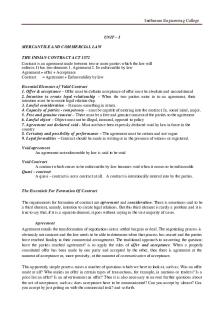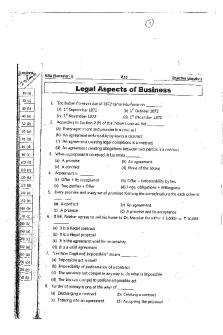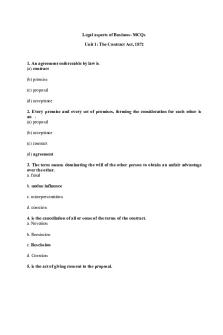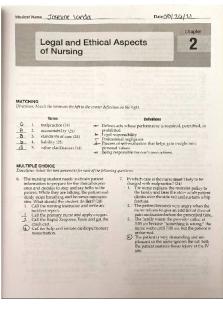MCQ - Legal Aspects of Business PDF

| Title | MCQ - Legal Aspects of Business |
|---|---|
| Author | Ishan Dhall |
| Course | Management of new ventures |
| Institution | ITM Group of Institutions |
| Pages | 25 |
| File Size | 108.4 KB |
| File Type | |
| Total Downloads | 104 |
| Total Views | 166 |
Summary
This data is MCQ for legal aspects of Business...
Description
1. Contract=Agreement + ________ A. enforceability by law B. rules C. clauses D. None of the above ANSWER: A 2. An agreement to do an impossible act A. legal B. void C. voidable D. illegal ANSWER: B 3. An advertisement to sell a thing by auction is _____________. A. an offer. B. an invitation to offer. C. no offer at all. D. a contract. ANSWER: B 4. a wagering agreement is _______. A. immoral B. forbidden by law C. opposed to public policy D. Legal prohibition ANSWER: B 5. A contract of guarantee should be _______. A. oral B. written C. oral or written D. none of the above ANSWER: C 6. Which the following strikes only at document and not transactions? A. The Transfer of Property Act, 1882 B. The Registration Act, 1908 C. both (A) and (B) D. None of these ANSWER: C 7. The offer may be communicated _____________. A. orally B. By conduct only C. By a written mode
D. All the above ANSWER: D 8. Which of the following is indicated by the abbreviation Ltd at the end of a company’s name? A. The shares are not transferable B. The shares may not be offered to the public C. The shares are freely transferable on the stock exchange D. None of the above ANSWER: B 9. Agreement=offer+ _______. A. acceptance B. rules C. clause D. validity ANSWER: A 10. A written ordinary resolution requires the approval of which of the following? A. More than 50% of those actually voting B. More than 50% of those entitled to vote C. Unanimous approval of those entitled to vote D. All of the above ANSWER: A 11. A sub-bailee is a person to whom the actual possession of goods is transferred by someone A. who is himself not an owner of goods B. who has a present right to possession of them as bailee of the owner C. both (A) and (B) D. None of these ANSWER: C 12. A contract creates_____________. A. rights in personam. B. rights in rem. C. only rights no obligations. D. only obligations and no rights. ANSWER: B 13. A supplies B, a lunatic, with necessaries suitable to his condition in life. A. A is entitled to be reimbursed from Bs property B. A is not entitled to be reimbursed from Bs property C. A is entitled to be given a share in Bs property D. None of these
ANSWER: A 14. An agreement not enforceable by law is said to _____________. A. void. B. voidable. C. valid. D. unenforceable. ANSWER: A 15. Which parties are bound by the terms of the tender when one party submits a tender? A. The person submitting the tender B. The person requesting the tender C. Neither party D. Both parties ANSWER: A 16. In the context of contract law, a bid at an auction is which of the following? A. An invitation to treat B. An acceptance C. A counter-offer D. An offer ANSWER: D 17. A supplies the wife and children of B, a lunatic, with necessaries suitable to their condition in life. A. A is entitled to be reimbursed from B’s property B. A is not entitled to be reimbursed from B’s property C. A is entitled to be given a share in B’s property D. None of these ANSWER: A 18. For necessaries of life _____________. A. A minor is liable B. A minor’s estate is liable C. The guardian is liable D. All the above ANSWER: B 19. What is the effect of a finding of contributory negligence in the law of tort? A. It removes the requirement to pay damages B. It reverses the payment of damages C. It decreases the level of damages D. All the above ANSWER: C
20. A specific offer can be accepted by _____________. A. any person. B. any friend of offered. C. a person to whom it is made. D. any friend of offeree. ANSWER: C 21. Consideration _____________. A. money B. money worth C. promise D. all the above ANSWER: D 22. Consideration must be something which the promisor _____________. A. is already bound to do. B. is not already bound to do. C. may voluntarily do. D. must not do. ANSWER: B 23. A supports B’s infant son. B promise to pay A’s expenses in so doing A. This is not a contract B. This is a contract C. either (A) or (B) D. None of these ANSWER: B 24. A, a tradesman, leaves goods at B’s house by mistake. B treats the goods as his own. A. He is not bound to pay A for them B. He is bound to pay partially A for them C. He is bound to pay A for them D. None of these ANSWER: C 25. A contracts to pay B a sum of money when B marries C. C dies without being married to B. A. The contract still can be forced B. The contract becomes void C. Either (A) or (B) D. None of these ANSWER: B 26. Contributory negligence arises as a result of the fault of which of the following?
A. A third party B. The respondent C. The claimant D. None of the above ANSWER: C 27. An agreement made without consideration is _____________. A. valid. B. illegal. C. voidable. D. void. ANSWER: D 28. A promise to subscribe to a charity. The promise is a _____________. A. voidable contract. B. void agreement. C. void contract. D. valid contract. ANSWER: C 29. A contracts to take in cargo for B at a foreign port. A’s Government afterwards declares war against the country in which the port is situated. A. The contract cannot become void when war is declared B. The contract becomes partly void when war is declared C. The contract becomes void when war is declared D. None of these ANSWER: C 30. On attainting the age of majority a minors agreement _____________. A. can be ratified by him. B. cannot be ratified by him. C. becomes void. D. becomes valid. ANSWER: B 31. Breach of which of the following terms does NOT allow the possibility of the aggrieved party terminating the contract? A. A condition B. An innominate term C. A warranty D. All the above ANSWER: C
32. Which of the following, in the context of entering into a contract, constitutes a binding offer to sell a unique item of furniture? A. Placing an advert in a newspaper with a price attached B. Placing it on display inside a shop with a price attached C. Telling someone the price you may be willing to accept for it D. Telling someone you will reduce the marked price on it by 10% ANSWER: D 33. Abe issued an invitation to tender for a contract and Bea submitted her terms. Which of the following statements is accurate? A. Abe made an offer and Bea made a counter-offer B. Abe made an offer which Bea accepted C. Both Abe and Bea made invitations to treat D. Abe made an invitation to treat and Bea made an offer ANSWER: D 34. A contract by an idiot is_____________. A. voidable. B. enforceable. C. invalid. D. void ab initio. ANSWER: D 35. A desires B, who owes him Rs. 100, to send him a note for Rs. 100 by post. A. The debt is discharged only when A receives the due amount B. The debt is discharged as soon as B puts into the post a letter containing the note duly addressed to A C. Either (A) or (B) D. None of these ANSWER: B 36. A fraudulently informs B that A’s estate is free from encumbrance. B thereupon buys the estate. The estate is subject to a mortgage. A. B may avoid the contract B. B may insist on its being carried out, and the mortgage- debt redeemed C. Either (A) or (B) D. None of these ANSWER: C 37. A gives a recognizance binding him in a penalty of Rs. 500 to appear in Court on a certain day. He forfeits his recognizance. A. He is not liable to pay the penalty B. He is liable to pay the penalty C. He is liable to partially pay the penalty D. None of these
ANSWER: B 38. A having advanced money to his son, B, during his minority, upon B’s coming of age obtains, by misuse of parental influence, a bond from B for a greater amount than the sum due in respect of the advance. A. A did not employ undue influence B. A employs undue influence C. Either (A) or (B) D. Either (A) or (B) ANSWER: B 39. A hires a horse in Calcutta from B expressly to march to Benaras. A rides with due care, but marches to Cuttack instead. The horse accidentally falls and is injured. A. A is not liable to make compensation to B for the injury to the horse B. A is partially liable to make compensation to B for the injury to the horse C. A is liable to make compensation to B for the injury to the horse D. None of these ANSWER: C 40. Which of the following is not a type of cybercrime? A. data theft B. stalking C. hacking D. antivirus ANSWER: D 41. Which of the following statements relating to limited liability partnerships is correct? A. They are limited to a maximum of 20 members B. They must have a minimum of two members C. They must have at least one unlimited member D. All the above ANSWER: B 42. Cyber-crime can be categorized into ________ types. A. 2 B. 3 C. 4 D. 5 ANSWER: A 43. Which of the following is not a type of peer-to-peer cyber-crime? A. phishing B. trojans C. MitM
D. credit card leak ANSWER: D 44. In the context of the law of agency, an agent will NOT be liable for a contract in which of the following instances? A. Where the agent fails to disclose that they are acting as such B. Where the agent intends to take the benefit of the contract and does not disclose they are acting as an agent C. Where the agent acts on their own behalf although claiming to be an agent D. None of the above ANSWER: A 45. Which of the following is not an example of a computer as weapon cybercrime? A. Credit card fraudulent B. Spying someone using keylogger C. IPR Violation D. Pornography ANSWER: B 46. Which of the following can be accepted so as to form a binding contract? A. A supply of information B. A quotation of price C. A statement of intent D. An agreement to enter into a future contract ANSWER: B 47. Contracts are legally enforceable agreements. Which of the following statements regarding contractual agreements is true? A. They must be in writing B. They must be evidenced in writing C. They need not be in writing D. None of the above ANSWER: C 48. Which of the following is not done by cybercriminals? A. Unauthorized account access B. Mass attack using Trojans as botnets C. Email spoofing and spamming D. Report vulnerability in any system ANSWER: D 49. Which of the following statements in relation to the issuing of bills of lading is true? A. Risk passes to the shipper B. Risk remains with the seller
C. Risk passes to the carrier D. Risk passes to the buyer ANSWER: D 50. What is the name of the IT law that India is having in the Indian legislature? A. India’s Technology (IT) Act, 2000 B. India’s Digital Information Technology (DIT) Act, 2000 C. India’s Information Technology (IT) Act, 2000 D. The Technology Act, 2008 ANSWER: C
51. In which year India’sIT Act came into existence? A. 2000 B. 2001 C. 2005 D. 2013 ANSWER: A 52. ________ agency is the most common form of agency. A. Incidental B. Express C. Apparent D. Implied ANSWER: B 53. A(n) ________ is a contract a principal and agent enter into that says the principal cannot employ another agent other than the one stated. A. ratified contract B. exclusive principal contract C. apparent agency contract D. exclusive agency contract ANSWER: D 54. Agency by ________ occurs when (1) a person misrepresents himself or herself as another’s agent when in fact he or she is not and (2) the purported principal accepts the unauthorized act. A. indemnification B. ramification C. ratification D. indoctrination ANSWER: C 55. Apparent agency is also referred to as ________. A. agency by estoppel B. express agency C. authorized agency
D. agency by default ANSWER: A 56. What is the full form of ITA-2000? A. Information Tech Act -2000 B. Indian Technology Act -2000 C. International Technology Act -2000 D. Information Technology Act -2000 ANSWER: D 57. Under which section of IT Act, stealing any digital asset or information is written a cyber-crime. A. 65 B. 65D C. 70 D. 17 ANSWER: A 58. What is the punishment in India for stealing computer documents, assets or any software source code from any organization, individual, or from any other means? A. 6 months of imprisonment and a fine of Rs. 50,000 B. 1 year of imprisonment and a fine of Rs. 100,000 C. 2 years of imprisonment and a fine of Rs. 250,000 D. 3 years of imprisonment and a fine of Rs. 500,000 ANSWER: D 59. The common law doctrine of ________ is based on the legal theory of ________ liability. A. respondeat superior; nefarious B. respondeat superior; vicarious C. respondeat inferior; nefarious D. respondeat inferior; vicarious ANSWER: B 60. What is the updated version of the IT Act, 2000? A. 2007 B. 2008 C. 2010 D. 2012 ANSWER: B 61. A(n) ________ agency results if a third party entering into a contract knows (1) that the agent is acting as an agent for a principal and (2) the actual identity of the principal. A. partially disclosed
B. undisclosed C. inherently disclosed D. fully disclosed ANSWER: D 62. A(n) ________ agency occurs if the agent discloses his or her agency status but does not reveal the principal’s identity and the third party does not know the principal’s identity from another source. A. fully disclosed B. partially disclosed C. undisclosed D. inherently disclosed ANSWER: B 63. A principal accepts an agent’s unauthorized contract through ________ of the contract. A. subornation B. subrogation C. ramification D. ratification ANSWER: D 64. Principals often employ persons and businesses that are not their employees to perform certain tasks on their behalf. These persons and businesses are called ________ contractors. A. dependent B. sub C. general D. independent ANSWER: D 65. Which of the following is not a method of terminating an agency relationship by acts of the parties? A. mutual agreement B. bankruptcy of the principal C. lapse of time D. achievement of agency purpose ANSWER: B 66. Which of the following is not a method of terminating an agency relationship by operation of law? A. death of either the principal or the agent B. insanity of either the principal or the agent C. mutual agreement D. bankruptcy of the principal ANSWER: C
67. What type of cyber-crime, its laws and punishments does section 66 of the Indian IT Act holds? A. Cracking or illegally hack into any system B. Putting antivirus into the victim C. Stealing data D. Stealing hardware components ANSWER: A 68. he Sale of Goods Act, was enacted on A. 15 March 1930 B. 18 April 1930 C. 5 April 1980 D. None of these ANSWER: A 69. The Sale of Goods Act, was enforced on A. 1st day of May, 1930 B. 1st day of June, 1930 C. 1st day of July, 1930 D. None of the above ANSWER: C 70. The Sale of Goods Act, 1930 is based on A. US Sale of Goods Act B. English Sale of Goods Act C. Indian Sale of Goods Act D. None of the above ANSWER: B 71. Section 2, of The Sale of Goods Act, is about A. definitions B. articles C. clauses D. none of these ANSWER: A 72. As per-section 2(1), a person who buys or agrees to buy goods is called A. buyer B. seller C. customer D. none ANSWER: A 73. The voluntary transfer of possession from one person to another is called A. delivery B. transfer C. hand over D. none
ANSWER: A 74. As per section 2 sub-section 8, of the Sales of Goods Act, insolvent means a person A. Who has ceased to pay his debts in the ordinary course of business B. Or can not pay his debts as they become due C. Both (a) and (b) D. None of above ANSWER: C 75. As per section 2(12), of the Sale of Goods Act, quality of goods include A. State of goods B. Conditions of goods C. Both (a) and (b) D. None of above ANSWER: C 76. The goods identified and agreed upon at the time a contract of sale is made are called A. ordinary goods B. specified C. opportunity D. none of the above ANSWER: B 77. There are_____, essential requisites of sale A. 2 B. 3 C. 5 D. none of the above ANSWER: D 78. Acceptance may be revoked by the acceptor A. at anytime B. before the letter of acceptance reaches the offerer C. before the death of other party D. none ANSWER: B 79. consideration must move at the desire of—A. the promisor B. the promisee C. promisor or any other party D. any other party ANSWER: A
80. An agreement with a minor is—A. valid B. void C. voidable D. none ANSWER: B 81. on attaining the age of majority a minor’s agreement A. becomes void B. becomes valid C. can be ratified by him D. cannot be ratified by him ANSWER: D 82. A contract by an idiot is—A. voidable B. enforceable C. invalid D. void ab initio ANSWER: D 83. The unlawful detention of any property is —— A. undue influence B. fraud C. mistake D. none of these ANSWER: A 84. If a new contract is substituted in place of an existing contract— A. alteration B. rescission C. waiver D. novation ANSWER: D 85. In case of breach of warranty,the buyer can —– A. repudiate B. return the goods C. claim damages D. none ANSWER: C 86. An administrator is appointed to realise a hierarchy of objectives. What is an administrator’s first and principal objective? A. To achieve a better result for the company’s creditors as a whole than would be likely if the company were wound up.
B. To realise property in order to make a distribution to one or more secured creditors. C. To rescue the company as a going concern. D. To wind the company up and distribute the assets to persons entitled to them. ANSWER: C 87. An administrator can be appointed in one of several different ways. Which ONE of the following is not a valid method of appointment? A. An administrator can be appointed by the court. B. An administrator can be appointed by a floating charge holder. C. An administrator can be appointed by the company’s auditor. D. An administrator can be appointed by the company. ANSWER: C 88. Regarding the proposal for a company voluntary arrangement, which ONE of the following statements is NOT true? A. If the company is in administration, the proposal will be made by the administrator. B. If the company is in liquidation, the proposal will be made by the liquidator. C. If the company is neither in administration or liquidation, the proposal can be made by the directors. D. If the company is neither in administration or liquidation, the proposal can be made by the members or creditors. ANSWER: C 89. Regarding the appointment of a receiver, which ONE of the following statements is NOT true A. A receiver may be a natural person or a body corporate. B. A charge holder can appoint a receiver if the instrument that created the charge states so. C. The court can appoint a receiver upon an application from a creditor. D. An undischarged bankrupt cannot normally act as a receiver. ANSWER: A 90. Which ONE of the following does NOT have the right to petition the court for a compulsory winding-up order? A. A member of the company. B. Any creditor of the company. C. The directors of the company. D. The auditor of the company. ANSWER: D 91. A compulsory winding-up order can only be made on a number of specified grounds. The majority of such orders are made on the basis of which ground? A. Where the company has resolved, by special resolution, to compulsorily wind up the company. B. Where the company is an ‘old public company.’
C. The company is unable to pay its debts. D. Where the company does not commence business within a year from its incorporation. ANSWER: C 92. Which ONE of the following statements describes the difference between a members’ voluntary winding up and a creditors’ voluntary winding-up A. If a majority of the directors make a declaration of solvency, the winding up will be a members’ voluntary winding up. If no such declaration is made, it will be a creditors’ voluntary winding up. B. A creditors’ voluntary winding up is commenced by the creditors, whereas a members’ voluntary winding up is commenced by the members. C. A members’ voluntary winding up is commenced by passing a special resolution, whereas a creditors’ voluntary winding-up does not require a special resolution. D. None of the above ANSWER: A 93. How does fraudulent trading under the Companies Act 2006 differ to fraudulent trading under the Insolvency Act 1986? A. Fraudulent trading under the Companies Act 2006 can apply at any time, whereas fraudulent trading under the Insolvency Act 1986 can only apply during the course of a winding-up. B. Fraudulent trading under the Companies Act 2006 imposes civil liability only, whereas fraudulent trading under the Insolvency Act 1986 imposes criminal liability also. C. There is no difference – both provisions are identical. D. Fraudulent trading under the Companies Act 2006 only applies to registered companies, whereas fraudulent trading under the Insolvency Act can also apply to partnerships and sole pro...
Similar Free PDFs

MCQ - Legal Aspects of Business
- 25 Pages

Legal Aspects of Business MCQs
- 26 Pages

Legal Aspects of Nursing
- 5 Pages

Behavioural Aspects of Budgeting
- 7 Pages
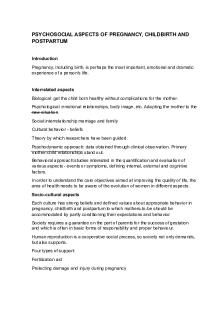
Psychosocial Aspects OF Pregnancy
- 19 Pages
Popular Institutions
- Tinajero National High School - Annex
- Politeknik Caltex Riau
- Yokohama City University
- SGT University
- University of Al-Qadisiyah
- Divine Word College of Vigan
- Techniek College Rotterdam
- Universidade de Santiago
- Universiti Teknologi MARA Cawangan Johor Kampus Pasir Gudang
- Poltekkes Kemenkes Yogyakarta
- Baguio City National High School
- Colegio san marcos
- preparatoria uno
- Centro de Bachillerato Tecnológico Industrial y de Servicios No. 107
- Dalian Maritime University
- Quang Trung Secondary School
- Colegio Tecnológico en Informática
- Corporación Regional de Educación Superior
- Grupo CEDVA
- Dar Al Uloom University
- Centro de Estudios Preuniversitarios de la Universidad Nacional de Ingeniería
- 上智大学
- Aakash International School, Nuna Majara
- San Felipe Neri Catholic School
- Kang Chiao International School - New Taipei City
- Misamis Occidental National High School
- Institución Educativa Escuela Normal Juan Ladrilleros
- Kolehiyo ng Pantukan
- Batanes State College
- Instituto Continental
- Sekolah Menengah Kejuruan Kesehatan Kaltara (Tarakan)
- Colegio de La Inmaculada Concepcion - Cebu
